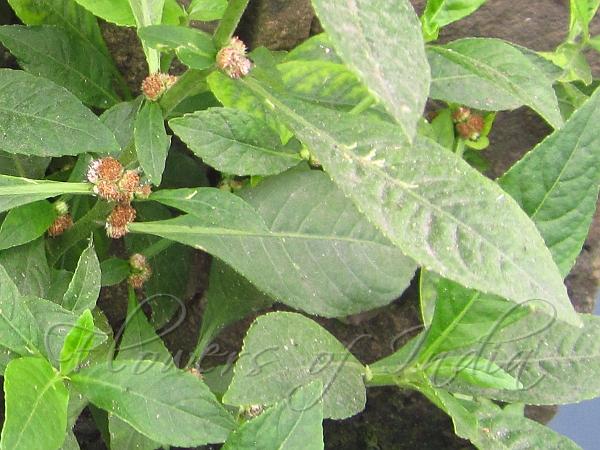|
| Yerba De Faja |
|

|

| File size | 287914 |
| Original date | 10/10/16 10:21 AM |
| Resolution | 1200 x 900 |
| Flash | Flash did not fire, auto |
| Focal length | 5.0mm |
| Exposure time | 1/80s |
| Aperture | 2.8 |
| Focus Distance | |
| Metering Mode | Multi-segment |
| Camera make | Canon |
| Camera model | Canon PowerShot A2200 |
| Sensor type | OneChipColorArea |
|
|
|
|
Photo: |
Botanical name: Struchium sparganophorum Family: Asteraceae (Sunflower family)
Synonyms: Ethulia sparganophora, Struchium herbaceum
Synonyms: Ethulia sparganophora, Struchium herbaceum
Yerba De Faja is an erect, branched, semi-aquatic
herbs, with stem green, sparsely finely velvet-hairy. Leaves are
alternate, elliptic-lanceshaped, base narrowed and decurrent on the
leaf-stalk at base, margins minutely toothed-finely toothed, tip
pointed or tapering; leaf-stalk to 2.5 cm long. Flower-heads are borne
in leaf-axils, stalkless, cluster of 4-5, about 5 mm across, spherical,
white, homogamous. Involucre in 4-5 series, outer smaller and inner
larger, triangular to inverted-lanceshaped, tapering, greenish, margins
scarious and hairy. Receptacle convex, pitted. Florets are all tubular,
without palea, 4-5 mm long, bisexual. Calyx of three white, 0.5 mm
long, pointed scales united variously, persistent. Flower 2-3 mm long,
white, tube narrow, lobes 5, spreading glandular. Stamens 3; filaments
thread-like, white. Ovary about 1.5 mm long; stigma bifid, purple.
Achenes about 1.5 mm long, triangular, blackish. Yerba De Faja is
native to Tropical America, naturalized in Western Ghats.
Medicinal uses: A tea made from the whole
plant is taken as a treatment for headaches, colds, wheezing, asthma
and backache. The juice of the whole plant is rubbed on cuts and
ulcers.
A tea made from the whole
plant is taken as a treatment for headaches, colds, wheezing, asthma
and backache. The juice of the whole plant is rubbed on cuts and
ulcers.
Medicinal uses:
 A tea made from the whole
plant is taken as a treatment for headaches, colds, wheezing, asthma
and backache. The juice of the whole plant is rubbed on cuts and
ulcers.
A tea made from the whole
plant is taken as a treatment for headaches, colds, wheezing, asthma
and backache. The juice of the whole plant is rubbed on cuts and
ulcers. | Identification credit: Regy Yohannan | Photographed in Kerala. |
• Is this flower misidentified? If yes,